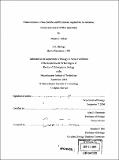| dc.contributor.advisor | Alan D. Grossman. | en_US |
| dc.contributor.author | Rokop, Megan E., 1978- | en_US |
| dc.contributor.other | Massachusetts Institute of Technology. Dept. of Biology. | en_US |
| dc.date.accessioned | 2005-09-27T17:39:16Z | |
| dc.date.available | 2005-09-27T17:39:16Z | |
| dc.date.issued | 2004 | en_US |
| dc.identifier.uri | http://hdl.handle.net/1721.1/28673 | |
| dc.description | Thesis (Ph. D.)--Massachusetts Institute of Technology, Dept. of Biology, 2004. | en_US |
| dc.description | "September 2004." | en_US |
| dc.description | Includes bibliographical references. | en_US |
| dc.description.abstract | (cont.) This is consistent with an inability of dnaBS371P cells to adjust the frequency of initiation according to growth rate. I also found that cells over-producing DnaBS371P are filamentous, contain decreased DNA contents, and are hypersensitive to DNA-damaging agents. These abnormalities may result from a defect in replication restart at damaged or stalled replication forks. Thus, whereas dnaBS3 71P suppresses the defects of mutant cells that cannot initiate or restart replication, expressing DnaBS371P in wild-type cells causes defects in initiation and restart. | en_US |
| dc.description.abstract | DnaB and DnaD are essential proteins that function in the initiation and control of DNA replication in Bacillus subtilis. I found that DnaB and DnaD are required to load the replicative helicase onto chromosomal origins during replication initiation. DnaB and DnaD are also involved in loading helicase during replication restart at sites of stalled replication forks. Despite the fact that DnaB and DnaD are thought to work together to load helicase, DnaB and DnaD are found in separate subcellular compartments. I showed that DnaB is found in the membrane fraction of cells, and DnaD is found in the cytoplasmic fraction. This separation could prevent helicase loading during the majority of the cell cycle. I isolated a missense mutation in dnaB, dnaBS371P, that disrupts the spatial separation of DnaB and DnaD. I isolated dnaBS371P as a suppressor of the temperature sensitivity of dnaBts cells and dnaDts cells. dnaBS3 71P also suppresses the growth defects of ipriA cells, which cannot restart replication at stalled forks. I found that a significant fraction of DnaD is found in the membrane fraction of dnaBS371P cells. In addition, I observed a direct interaction between DnaBS371P and DnaD that is not observed between the wild-type proteins. I hypothesize that the DnaB-DnaD interaction is regulated, thereby controlling when these two proteins converge at the membrane to coordinate helicase loading. dnaBS3 71P cells lack proper control of replication, suggesting that the spatial separation of DnaB and DnaD is an important mechanism of replication control in B. subtilis. I showed that dnaBS371P cells over-initiate replication when grown slowly in minimal medium, but contain decreased DNA content when grown faster, in rich medium. | en_US |
| dc.description.statementofresponsibility | by Megan E. Rokop. | en_US |
| dc.format.extent | 254 p. | en_US |
| dc.format.extent | 8187139 bytes | |
| dc.format.extent | 8220953 bytes | |
| dc.format.mimetype | application/pdf | |
| dc.format.mimetype | application/pdf | |
| dc.language.iso | en_US | |
| dc.publisher | Massachusetts Institute of Technology | en_US |
| dc.rights | M.I.T. theses are protected by copyright. They may be viewed from this source for any purpose, but reproduction or distribution in any format is prohibited without written permission. See provided URL for inquiries about permission. | en_US |
| dc.rights.uri | http://dspace.mit.edu/handle/1721.1/7582 | |
| dc.subject | Biology. | en_US |
| dc.title | Characterization of two Bacillus subtilis proteins required for the initiation, restart, and control of DNA replication | en_US |
| dc.type | Thesis | en_US |
| dc.description.degree | Ph.D. | en_US |
| dc.contributor.department | Massachusetts Institute of Technology. Department of Biology | |
| dc.identifier.oclc | 58994941 | en_US |
